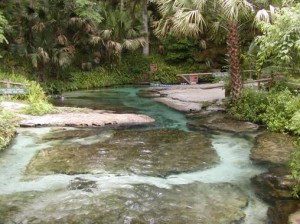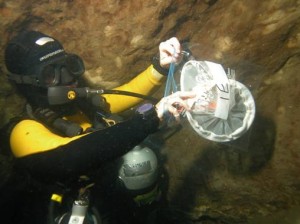Florida Springs Project Overview
The Florida Springs Project began in 1999 with the initial exploration, survey, mapping, and monitoring of several springs (Wekiwa, DeLeon, Rock, Palm, Sanlando, Sulfur, Witherington, Blue, Hardin, Nova, etc.) in the central Florida area. These springs, unlike those dived recreationally in north Florida, typically have narrower conduits, and thus higher flow making access difficult and limited. In 2004, we began a collaborative project with Rima Franklin, Ph.D., and Aaron Mills, Ph.D., two microbial ecologists whose research focuses on bacteria in extreme environments. Since these submerged caves are essentially devoid of sunlight and oxygen, understanding how these habitats support life is critical.
Sample sites include several locations in Florida, as well as Bermuda and the Yucatan Peninsula of Mexico, and assessment of each site’s hydrology and groundwater geochemistry provides the environmental context for interpreting these data. In addition, the biogeography of the microbes is examined to determine if there are populations that are endemic to a particular cave, watershed, or even region. This project – The Diversity and Biogeography of Microbial Communities in Submerged Caves – is supported by a grant from the National Science Foundation’s Systematic Biology and Biodiversity Inventories Cluster and involves an intense examination of these systems.
While it is becoming increasingly evident that bacteria play a vital role in facilitating the geochemical reactions that have helped shape many environments here on Earth, this interplay of biological and geological process and product is at the center of the our study, which investigates the diversity and activity of microorganisms in karst environments and submerged caves. Over the past 15 years, interest in cave geomicrobiology has grown; however, this work has largely been restricted to subaerial (“dry” or “vadose”) caves and sites that are relatively easy to access; little research has been conducted in submerged cave systems. Given that submerged caves represent accessible windows to deeper groundwater environments, they are an important area for further study. This research represents the first in-depth, quantitative study of microbial ecology in submerged freshwater caves.
Just as the activities of farming, industrial production, and fecal, municipal, and hazardous waste disposal have had deleterious effects on the quality of surface water, groundwater and cave water have also been negatively impacted. Though the mounting environmental threat to these systems has led to increased research into subterranean systems, including aquifers, caves, and karst windows, to most of us, these habitats still remain “out of sight, out of mind.” This has consequences for humans, in terms of contamination of drinking water supplies, and for the unique and fragile ecosystems that thrive within karst systems. This research fills a fundamental gap in our understanding of the microbiology and geochemistry of karst aquifers, and lays the foundation for: (1) increased understanding of the role microbial communities may have in the formation of karst features (speleogenesis) and in the functioning of cave ecosystems, (2) a better understanding of groundwater biogeochemistry, and (3) exploration of the role that microbial chemolitho(auto)trophic production may play in subterranean food webs. Survey data are shared with the Florida Department of Environmental Protection in order to better understand the patterns and pathways of flow. In addition to the principal investigators, project directors include Amy Giannotti, Renee Power, Terrence Tysall, and Marissa Williams.
Click here to see daily updates during the project work. Notice at the upper right of the updates preview page you can click on the year of interest in order to limit the amount of updates previewed.





